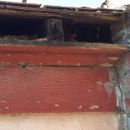Calculating NFA for metal roof attic
What amount of venting would you recommend for this attic/roof system?
Presently unvented. Tar paper and 1020’s asbestos shingles with redwood gutters painted with lead based paint.
New roof: standing seam metal with solar.
In a high fire zone.
1500 square foot insulated attic, 6:12 pitch, or about 1600 square feet of actual roof material.
Current venting: none.
Mechanical in attic: none
Climate zone: 3C
Quake Distance: 101 meters to major fault main trace, outside Alquist Priolo Special Studies Zone.
Width of overhangs about 4 inches all around.
Length of new metal ridge: 19 feet, NFA of available ridge vents appears by be 17 in/sq NFA per lineal foot.
Using “1 square foot of vent per 150 square feet of attic” I get a NFA of 720 square inches total (divided by 2 for eave and ridge). Using GAF’s online calculator for shingles gives 360 square inches, so same number.
(IRC), Section R806 seems to be exactly half that.
Your thoughts energy nerds?
GBA Detail Library
A collection of one thousand construction details organized by climate and house part










Replies
Hi Bryce,
Have you read this article? I think it will answer your questions.
All About Attic Venting
Read that, not very specific to my climate or situation.
I think in a wildfire area it would be better to design for an unvented roof. No vents, no chance of embers making the way in.
An over roof with either foam+plywood or purlins+mineral wool batts+plywood can work quite well. In milder climate, unless the inspector tells you otherwise, even an R20 roof is decent. You can get there with 3.5" of polyiso or 2x6 purlins with R23 batts.
Out of the sparks and into the fire. The problem with foam is you have to protect the foam from catching fire.
https://foursevenfive.com/blog/reason-foam-fails-2-unacceptable-fire-hazard/
https://www.greenbuildingadvisor.com/question/exterior-foam-and-fires
The California Urban Interface Codes provide some guidance
https://up.codes/viewer/california/ca-fire-code-2016/chapter/49/requirements-for-wildland-urban-interface-fire-areas#49
Here we're using intumescent vents:
https://www.vulcanvents.com/
But the QUESTION on the table for GBA is how much NFA of venting should we be using?
Section R806.2 requires 1/150 unless you use the exception that allows 1/300 if you split the venting high & low on the roof. 1,500/150=1,440 sqin and the exception of 1/300 = 1,500sf/300= 720 sqin.
I think you made a math error.
Make sure to upgrade the facia & eaves to the Wildland code. On my projects we try to stay away from eave soffit vents due to cost, we place a vent low on the roof deck. Usually O'hagin brand they work well with comp shingle.
Makes sure you have the right underlayment on the roof deck to get a Class A rated Roof. A metal roof alone is not enough.
Thanks for the tip on underlayment. I called the vendor.
Both the roofer and inspector missed the underlayment, specifying and giving an OK to high temperature peel and stick. I spoke to the metal vendor employee who actually did their UL Class A tests, and who stated the peel and sticks just melt. He recommended GAF VersaSheild on top of #30 felt, and provided a long list of tested Class A assemblies and a verbal description of what failed, melted or caught fire. Ouch.
The GAF tool is https://www.gaf.com/en-us/for-professionals/tools/ventilation-calculator and gives exactly:
360 Minimum Sq. In. of Net Free Area of exhaust needed at or near the ridge.
360 Minimum Sq. In. of Net Free Area of intake needed at or near the soffit.
Still would the energy nerds want to follow exactly code, given all the GBA ink on why attic venting, and all of Martin's "hate speech" on conventional venting!
Glad to help on the roof.
The versashield is a fiberglass roll based underlayment. The other option is DensDeck which is a gypsum based board.
Either option allows the metal roof to get a class A assembly. They should have a Report on how to construct the assembly that meet the Class A requirements.
VersaShield seems to come in multiple versions: "Solo", "Regular". The metal company report is TGFU.R9697, though it's a bit confusing as it seems to allow various seemingly unsafe foam assemblies exposed to ignition from the top:
http://productspec.ul.com/document.php?id=TGFU.R9697
Remember the metal vendor guy who did the work says the self sticks melt and sag. Why they are listed as class A in the document is unclear.
"NC" means "Non-combustible".
-------------------------------------------------------------------------------------------------------
For eave venting current plan is Vulcan VSC2120-5, cut into 1 foot sections. Each vent is rated to 9.4" NFA, leading to a total of 376 square inches NFA at the eaves.
I can't find a rated ridge vent, but my area does not require a rated ridge vent, so I'll get close with a Snap-Z ridge at 17 in/sq NFA per lineal foot, giving a total of 323 in/sq NFA at the ridge.
Not sure if it will work- check https://www.brandguardvents.com/products.php the ridge vents at the top of the page are Class A rated.
Unfortunately the Brand Guard Vents are shingle specific, not for standing seam.